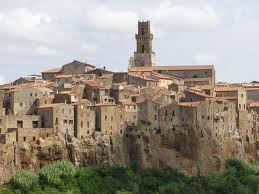"Leap, and the net will appear." I'm hoping this is true, for I have taken an almighty leap by relocating to Rome from Canada. Italy has long exerted an enormous pull, so let's see what this gigantic leap will bring!
Tuesday, 18 June 2013
Some Treasures of Tuscany
I was so fortunate last weekend to spend a few days in the Maremma region of Tuscany, staying with my friends Stefania and Paolo in their beautiful apartment in Manciano. The sun was wonderfully hot on their rooftop terrace, with such stunning views of the medieval town that it felt perfect. The rest of the house is protected by metre-thick stone walls, making it blissfully cool inside.Of course, some of us love the heat!
Late at night, we saw so many stars from the terrace (to say nothing of the shadows cast by an imposing fortress built around 1424 when the town was briefly occupied by the Republic of Siena.)
Growing up out of the rocky hilltop was the nearby town of Pitigliano, whose history dates to Etruscan times, long before the Romans swept through Italy; long before Christianity.
The Etruscans hollowed caves out of the tufo rock which were later used as bakeries by the Jewish population that gave Pitigliano its second name, "Little Jerusalem". Jews fleeing persecution in other parts of Italy settled in Pitigliano which for several hundred years was a frontier town between the Grand Duchy of Tuscany and, to the south, the Papal States.
Sorano is another ancient town carved from the tufo rock of the area and also dates from Etruscan times. Today, it is filled with lovely little shops - some selling fantastic local cheese.
Like many communities in this part of Tuscany, it had been dominated by the Republic of Siena and later, the Orsini family. Both of which left their mark in great towers and fortresses.
I had no idea the coastline of Maremma, running along the Tyrrhenian coast from Grosseto to Capalbio, would be so beautiful, rivaling the far more popular and crowded Amalfi in places. I was fascinated by a thickly wooded promontory named L’Argentario.
Apparently, this has long been a vacation spot for wealthy Romans and includes such towns as the yacht-filled Porto Santo Stefano, and the colorful Porto Ercole, where the Baroque painter Caravaggio died of malaria in July 1610.
From view points, we could easily see across to the infamous island of Giglio (where the Costa Concordia crashed in January 2012, killing at least 30 people and injuring 64 with 4,200 evacuated from the luxury liner.) Stefania told me that on a clear day, the island of Corsica was also visible.
We took a delightful stroll through the nearby fishing port of Orbetello, with its blue-tinged lagoon.
And all this only a 90-minute drive north of Rome! Hmmm, I think I could be tempted to rent Stefania's cozy holiday apartment on the cool ground-floor and stay awhile....
Friday, 14 June 2013
Florence: Great art, great food, great friends, great discoveries
I made a few fabulous discoveries Thursday when I dashed up to Firenze, but I also enjoyed some old favourites.
I wanted to spend the day with Ottawa friends Marcie and David, and we began with a lovely lunch at one of my favourite restaurants: the ever-reliable Osteria Pepo on Via Rosina, just around the corner from the Mercato Centrale. As always, I had their brilliant pappardelle al cinghiale (I love wild boar!) The sauce had surely been simmered for several hours to become so rich and flavourful.
But first, on my way their apartment, I stumbled across a tiny gem: a museum dedicated entirely to Umbrian master Perugino, the space dominated by a striking and dramatic fresco of the Last Supper. The Cenacle of Fuligno museo is located in the refectory of the former convent of St. Onofrio on Via Faenza, once home to the Franciscan nuns of Foligno.
After the nuns were evicted in 1803, the Last Supper fresco in its refectory was covered with a layer of plaster. In 1845 the fresco known as "Il Cenacolo di Foligno" was cleaned, and the discovery was published as a work by Raphael. Debate raged for decades over the attribution until more recently, it was deemed to be a Perugino work.
This little spot seems to be open about four hours per week, and entry is free if you can guess when to arrive. I do love stumbling across art unexpectedly.
We were all interested in visiting my old favourite, the Galleria Palatina in the Palazzo Pitti, which also had an underwhelming exhibition on the role of dreams in Renaissance art. To me, the show failed to meet its brilliant premise.
But Santo Spirito more than made up for the lacklustre exhibit. I had never before been able to get inside this great basilica in the Oltrarno section of Florence but on this day, I finally arrived during opening hours and was richly rewarded. The enormous space, based on designs by Filippo Brunelleschi, is crammed with great frescos, paintings, and of course, the wooden crucifix sculpted by a 17-year-old Michelangelo and bearing an equally young, slim, fragile Christ.
I was gobsmacked by the rich beauty of the Ghirlandaio frescos (Michelangelo was one of Domenico Ghirlandaio's apprentices) in the Sassetti Chapel depicting the life of St. Francis of Assisi. (No photos but above is The Resurrection of the Boy from the Web Gallery of Art.)
Subscribe to:
Posts (Atom)

















